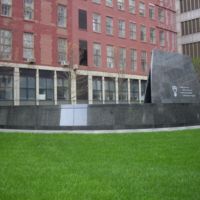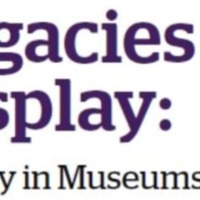
African Burial Ground National Monument
The memorial was founded after human remains were discovered underground by city workmen who were attempting to build some government offices in the 1990s. The remains belonged to enslaved Africans who were building New Amsterdam (present day New York). The African Burial Ground National Monument honours these Africans’ memory, having reburied them in a more respectful manner. It is the oldest and largest known excavated burial ground in North America for both free and enslaved Africans. A 'sacred space in Manhattan', the mission of the memorial is to acknowledge New York's involvement with slavery and the slave trade to provide a respectful and symbolic space for the reinternment of the African remains found at the site.
The facilities at the centre include a range of exhibits, a twenty-minute film and a book/gift shop. In addition, the memorial also offers on-site presentations in the visitor centre consisting of an hour long programme. The memorial is managed by the National Park Service and the U.S Department of the Interior.
The process of memorialization and the research conducted about the enslaved African skeletal remains was negotiated extensively between the General Services Administration, the African American descendant community, historians, archaeologists, and anthropologists. Civic engagement led to the ancestral remains reinternment within the original site of discovery. An external memorial, an interpretive centre, and research library were constructed to further commemorate the financial and physical contributions of enslaved Africans to colonial New York, and to honour their memory. The exhibits examine the history of the initial discovery, the research conducted to identify the remains, the documentation process and associated artefacts.

America's Black Holocaust Museum
The museum was founded in 1984 by Dr James Cameron, a self-taught historian and public speaker. The only known survivor of a lynching, Dr Cameron used his survival experience to provide visitors with a unique view of ‘living history’. Alongside this, he expanded the museum’s exhibits and employed staff, attracting local, national and international visitors. Unfortunately, the site closed following Dr Cameron’s passing in 2006 and the economic downturn of 2008. Since 2012 America’s Black Holocaust Museum has existed as a virtual museum. It seeks to educate the public of injustices suffered by people of African-American heritage, while providing visitors with an opportunity to rethink their assumptions about race and racism. It offers a range of online exhibitions, including one about the history of the museum, and another on the perpetuation of slavery through three centuries.
There are nine exhibitions available to be accessed within the virtual museum, seven of which are a chronological study of the history of Africans in America. All of them feature the museum’s four key themes: remembrance, resistance, redemption and reconciliation. Beginning with a view of life in Africa prior to enslavement, they end with an exhibition entitled ‘Now- Free at Last?’ which considers the experiences of African Americans from the 1980s up to the present day. In addition to the chronological displays, there are three special exhibitions, two of which are concerned with the victims of lynching. Within the website there are photographs, and images of objects, alongside suggestions of further reading material. There is also a section of relevant and important news articles. The virtual museum is a member of the international Coalition of Sites of Conscience, and the Association of African American Museums. The museum runs a programme of events and speakers, and is due to re-open in a physical building in Milwaukee during the Autumn of 2018.